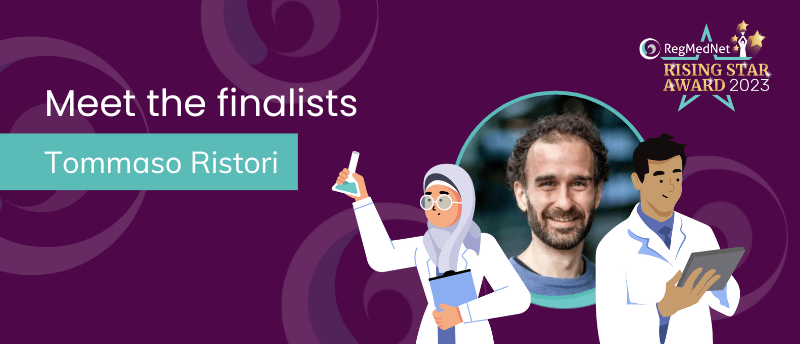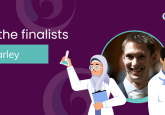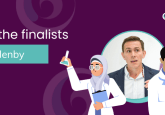Tommaso Ristori: RegMedNet Rising Star Award Finalist

We are pleased to announce that our judges have shortlisted three outstanding finalists for the RegMedNet Rising Star Award. Tommaso Ristori is a Tenure-Track Assistant Professor at Eindhoven University of Technology (Netherlands) with a multidisciplinary background in theoretical and applied mathematics, biomedical engineering and tissue engineering.
Read more about Tommaso’s career and contribution to the field.
Describe the main highlights of your regenerative medicine work
My work impacted regenerative medicine knowledge at several levels and timescales, from tissue-level collagen remodeling to subcellular cell-cell signaling. This was achieved through multidisciplinary research, building on my strengths in computational techniques applied to biology.
During my PhD, I developed mathematical models and algorithms to predict and explain the remodeling of cells and collagen fibers in soft tissues. For the first time, I was able to simulate and predict years of cell and collagen remodeling in native and tissue-engineered heart valves (TEHVs) in response to both topographical and mechanical stimuli. Next, I combined algorithms with experiments to unravel the biophysical mechanisms underlying cell (re)orientation in response to these stimuli. During my postdoc, I combined models of vessel mechanics and cell-cell signaling to identify the main mechanisms ensuring blood vessel homeostasis in health and disease.
Finally, during my assistant professorship, I combined experiments and simulations to predict and understand the spatiotemporal control of angiogenic sprouts via perturbations of cell-cell (Notch) signaling. Importantly, my research led to the identification of new links between Bmp9 and Notch signaling and demonstrated the functional relevance of these new features for pathologies such as arteriovenous malformations, potentially inspiring future therapies.
How has your work impacted your laboratory, the regenerative medicine field and beyond?
The algorithms that I proposed in my PhD thesis were adopted to successfully predict the remodeling of THEVs and were a key component in a recent breakthrough study concerning the improved long-term functionality of TEHVs. My computational models are currently being adopted and extended by other PhDs to further optimize the design of TEHVs. Moreover, my computational models of cell (re)orientation and cell-cell signaling were key to explaining cell experiments from collaborators and, especially, inspiring new experiments uncovering previously unknown phenomena, such as the upregulation of LFng in endothelial cells, linking Bmp9 and Notch signaling in endothelial cells during angiogenesis. These computational models are currently being extended and experimentally validated by other PhDs in my group.
Describe the most difficult challenge you have encountered in your scientific career and how you overcame it
Given my academic background in theoretical mathematics, the most difficult challenges in my career have been given by the need to switch fields and learn new competencies to reach my scientific goals to impact the regenerative medicine field via mathematical methods. After my Master’s degree in theoretical mathematics, I performed a PhD in biomedical engineering and a postdoc performing cell experiments; I had to quickly learn new concepts and other ways to communicate with my collaborators coming from completely different fields. This was achieved by continuous discussions with colleagues, sharing and explaining each other’s research topics; frequent presentations to the group or at regenerative medicine conferences; and reading several regenerative medicine papers, later writing peer-reviewed literature reviews on related subjects.
Coming from a different mindset, I was able to overcome challenges by thinking outside of the box. For example, when I started my PhD, the simulations of heart valve remodeling would have taken years to complete. By approaching the challenge from a mathematical perspective rather than via biological approximations, I was able to tremendously accelerate the simulations, which would then take only days, while keeping the main biological assumptions at the basis of the computational model.
Can you describe how you try to give back to the community/support a cause you feel passionate about? (i.e., describe your role in regenerative medicine focus groups, inter-disciplinary groups, internal workshops)
Over the years, I have tried to give back to the communities I was part of, by being part of societies and by organizing events. For example, during my PhD, I was part of a PhD association (HoraEst) that organized social events for PhD candidates of the Departments of Biomedical and Mechanical Engineering of the Eindhoven University of Technology (Netherlands). These events were essential to improve the well-being of PhD candidates and foster collaborations.
Later on, I tried to enhance the visibility of the field focused on combining experiments and simulations in regenerative medicine by organizing a pre-meeting workshop at the International Society for Applied Cardiovascular Biology meeting (September 2018; Bordeaux, France). This meeting was intended for PhDs and postdocs to learn about experimental and computational methods in the field of applied cardiovascular biology.
Now, in addition to being active as a peer reviewer for scientific journals and conference prizes (e.g., best thesis and poster awards), I am responsible for the organization of an internal weekly meeting held to foster collaborations among PhD candidates from six different principal investigators at the Eindhoven University of Technology, in the Department of Biomedical Engineering.
The decision is in your hands, so choose wisely! Have a browse of all the candidates, and make sure to cast your vote today.

